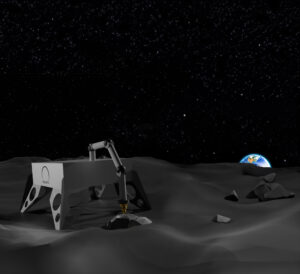Company Spotlight: Regolithix – Fuelling Space Exploration
Marketing

Our Moon has played an important role coexisting with Earth, long before Neil Armstrong and Buzz Aldrin left their iconic footsteps as part of the Apollo programme. The Moon ensures stability for life on Earth moderating our home planets wobble on its axis; leading to a relatively stable climate. Through a gravitational pull between the Earth and the Moon we also experience tidal patterns. Modern missions like NASA’s Artemis program, and ESA’s plan for a Moon Village indicate that humanity is imminently planning a return to the moon. Alongside the renewed efforts to return to the moon are the continued developments of the lunar economy. One such notable component of the Artemis programme is NASA’s Gateway – A multi-purpose space station orbiting the Moon, providing sustained support for humanities return to our lunar surface and beyond.

Image credit: D-Orbit
Through the Artemis program, NASA has signalled that the Moon will be the first site beyond Earth for sustainable surface exploration. While technological development continues and innovation develops around human life-support, it is important we consider new models in space exploration from ‘there and back again’ to ‘there to stay’. In 2022, ICON was awarded a 57 million dollar contract with NASA to develop 3D printers for developing the built environment on the Moon. Through development focused on advanced construction of settlements, companies such as ICON look set to revolutionise space exploration on the Moon and beyond. For companies like ICON, consideration of which materials to use as the building blocks for Earth’s outpost will become paramount. These collective efforts are driven by the need to make humanity a spacefaring civilisation.
The Moon features an abundance of one material, regolith, which covers almost the entirety of the lunar surface. Lunar regolith is essentially loose or fine material found covering solid rock. This material has formed over the last 4.6 billion years from the impact of large and small meteoroids. The lunar surface regolith can vary in thickness at different locations. In Mare areas of the Moon its generally 4-5 metres thick, however in older highland regions this can be 10-15 metres. Below this is a region of blocky and fractured bedrock created by larger impacts, referred to as ‘Megaregolith’.
Regolithix is a young UK startup developing lunar regolith processing methods for both material manufacturing and oxygen extraction. The company’s co-founder, Ed Cudworth explains that if humans are not only to survive but thrive long-term on other celestial bodies, in-situ resource utilisation (ISRU) needs to be an essential part of the plan. The cost of bringing resources from Earth is costly, Ed remarks how at present companies like SpaceX estimate a cost of 1000 dollars per kilogram sent into space. Although this cost is reducing, it can be an inefficient process in the long term for some resources. Some of the main resources that will be essential to human survival are oxygen for life support and water. Water can also be split into oxygen and hydrogen to use as fuel, amongst other applications. In addition, various metals are essential for Integrated Circuit (IC) manufacturing, predominately silicon for both microchips and semiconductors. Within Ed’s aspirations for a multiplanetary species, he suggests that utilising regolith in-situ will permit not only oxygen production but building materials for settlements, as well as materials for repairing and refuelling spacecraft.
“The ability to produce and source the most important building blocks in space, is going to be a huge leap forward for us. Ultimately, we could see a huge step in the right direction in transforming mankind into a multiplanetary species.”
Regolithix first formed when co-founders Ed Cudworth and Ryan Wiseman attended an event hosted by both the Royal Astronautical Society. In the conference it was explained that lunar regolith samples returned from the moon consisted of up to forty five percent oxygen by weight. This oxygen is chemically bound in the material as oxides in the form of minerals or glass, although unavailable for immediate use its efficient extraction would prove to be an extremely valuable capability. Inspired by this initial discussion, Ed and Ryan then began investigating new innovative methods for extracting oxygen from lunar regolith. The co-founders of Regolithix have developed their own novel method for extraction utilising high frequency plasma.
With their method on Earth-based regolith simulant, Regolithix have been able to process the simulant into oxygen, metals, and minerals. This pioneering feat indicates that Regolithix have a valid solution for oxygen production off-Earth. Regolithix also intend to utilise both metals and minerals to produce and supply feedstock for 3D printing. Ed describes the extracted materials as “very precise and very fine particles which are perfect for laser sintering and 3D printing.” Through Regolithix’s extractive capabilities they aim to supply building materials for humanity to build structures on the Moon through additive manufacturing.
In addition to the benefits of oxygen, materials, and building supplies, Ed notes “generally the power requirements are a lot smaller, and the system as a whole is a lot smaller and compatible. So, it can be tailored towards not just large missions, but small missions as well”. In this forward-thinking manner Regolithix’s power requirements and form factor enable both a reduction in cost and longevity in use.
“We fuel rockets, create both oxygen and water as well as extract metals and minerals. Being able to do that from a single kind of source – the lunar regolith – that’s just super exciting!”


Above images: Renders of the Regolith processor on the moon. Image credit: D-Orbit
Ed suggests that the regolith processor will be autonomous, he describes it as “Being able to be utilised before human habitation and it being able to be used as a remote system”. Although the goal is for lunar settlements to be inhabited, Regolithix’s co-founders envision their position in the lunar economy to be at the very beginning. Their autonomous regolith processor could be initially installed on the Moon without human presence, allowing Regolithix to support the development of lunar infrastructure prior to habitation. Ed also notes the potential of the system to be integrated into a customer’s spacecraft and used for specific missions elsewhere.
Noting the importance of government support within the industry, Ed explains how Regolithix was part of one of the first cohorts of the LEO accelerator programme ran by the UK Space Agency. Ed describes how they entered the accelerator early in their business’s start up; “We’d come up with an idea and we had a name for the company and that was about it”. Through the program they were able to build their business plan, access mentor support, contact potential clients and received legal advice on subjects like intellectual property. Though they are still in the early stages of their business, Regolithix has recruited a couple other experts. When asked about how Regolithix draws in fresh faces, Ed remarks how whether individuals come from the space sector or not they have all been very enthusiastic and interested in contributing wherever they can.
Though the lunar economy and lunar settlements seems far on the horizon for many, Ed and Regolithix are optimistic. Ed notes how small business can focus upon niche services or products and quickly fail and grow, building from these failures. Regolithix is one of the many small businesses that make up an essential part of the space ecosystem, and as Ed aptly states “It’s really the only way forward because I don’t think there’s just one solution being provided for space. It’s got to be a team effort.” One essential part of their steadfastness is knowing the capacity and advantage that startups have within the sector. When speaking of the industries and infrastructure to develop on the Moon, Ed asserts “It will be done by small commercial startups, that’s what keeps us going. It’s knowing that space is a place for small companies and startups to really grow and achieve great things that in other industries are much harder to achieve.” Expanding upon this, Ed describes how small businesses and startups can innovate and be dynamic; quickly adapting to new situations and realisations without being too constrained. Whilst large organisations must consider “appeasing investors and constant share growth”.




